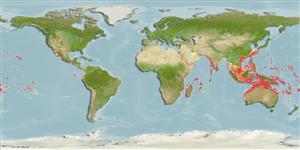Common names from other countries
Classification / Names / Names
Nomes comuns | Sinónimos | Catalog of Fishes (gen., sp.) | ITIS | CoL | WoRMS
Environment: milieu / climate zone / depth range / distribution range
Ecologia
Pelágico(a,os,as); intervalo de profundidade 0 - 200 m (Ref. 83943). Tropical; 30°N - 48°S, 16°E - 134°E
Indo-Pacific.
Length at first maturity / Tamanho / Peso / Idade
Maturity: Lm ? range ? - ? cm Max length : 2.2 cm BL macho/indeterminado; (Ref. 8281)
This is an epipelagic species (Refs. 83943, 116365). Chaetognaths are active carnivores, feeding mostly on copepods, crustacean larvae and other chaetognaths, and occasionally on forams and fish larvae (Ref. 81541).
Life cycle and mating behavior
Maturidade | Reprodução | Desova | Ovos | Fecundidade | Larvas
Members of the phylum Chaetognatha are hermaphroditic. Mating behavior: A preliminary visual signaling behavior for species recognition is observed to prevent predation. Life cycle: Eggs directly develop into miniature adults (hatchlings).
Lutschinger, S. 1993. (Ref. 8281)
Categoria na Lista Vermelha da IUCN (Ref. 130435)
Categoria CITES (Ref. 108899)
Not Evaluated
Not Evaluated
Utilização humana
| FishSource |
Ferramentas
Mais informação
Nomes comunsSinónimosPredadoresReproduçãoMaturidadeDesovaFecundidadeOvosDesenvolvimento dos ovos
Idade/TamanhoCrescimentoComprimento-pesoComprimento-comprimentoMorfologiaLarvasAbundância
Fontes da internet
Estimates based on models
Preferred temperature
(Ref.
115969): 21.6 - 28.3, mean 26.6 (based on 590 cells).
Vulnerabilidade
Low vulnerability (10 of 100).
Categoria de preço
Unknown.
